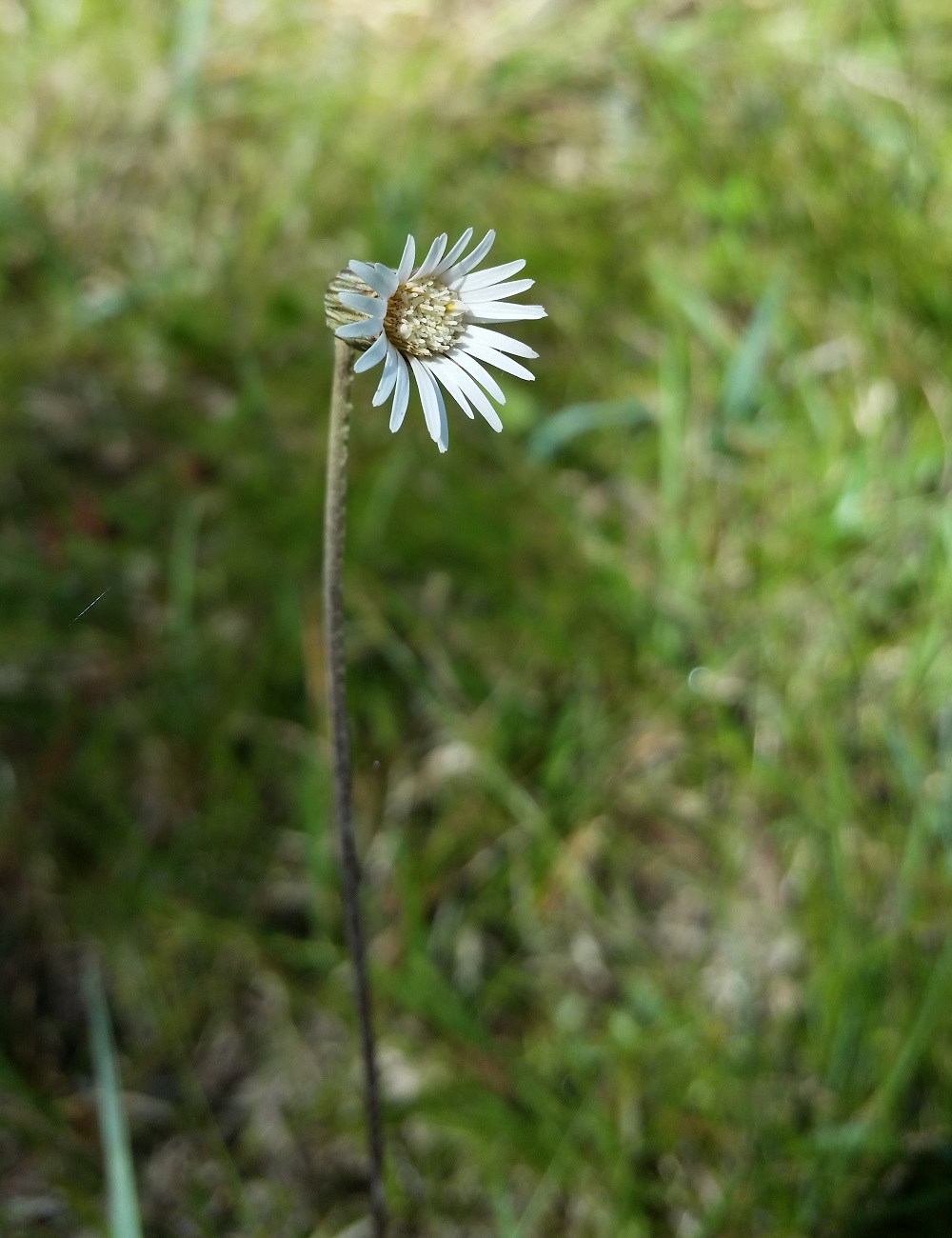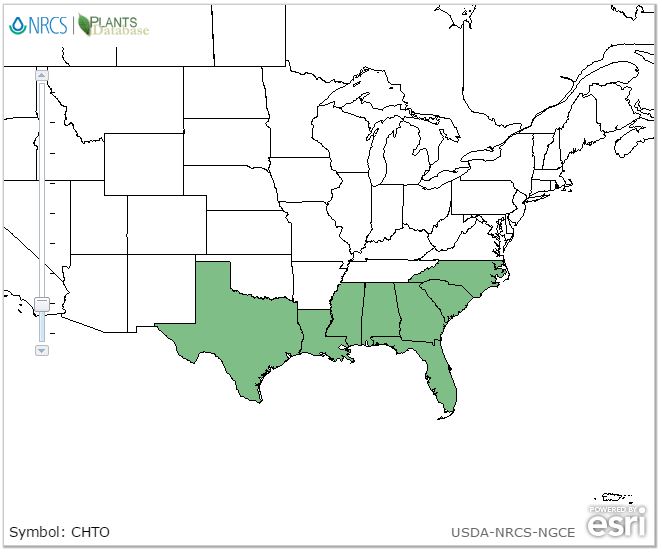Chaptalia tomentosa
| Chaptalia tomentosa | |
|---|---|

| |
| Photo by Katelin Pearson | |
| Scientific classification | |
| Kingdom: | Plantae |
| Division: | Magnoliophyta - Flowering plants |
| Class: | Magnoliopsida - Dicotyledons |
| Order: | Asterales |
| Family: | Asteraceae |
| Genus: | Chaptalia |
| Species: | C. tomentosa |
| Binomial name | |
| Chaptalia tomentosa Vent. | |

| |
| Natural range of Chaptalia tomentosa from USDA NRCS [1]. | |
Common names: Woolly Sunbonnets; Pineland Daisy; Night-nodding Bog-dandelion; Sunbonnets
Contents
Taxonomic notes
Synonyms: none
Varieties: none
Description
C. tomentosa ia a perennial forb/herb that is a member of the Asteraceae family.[1] Leaf shape varies from elliptic to obovate, and leaf margins denticulate. Fruit type produced is an achene. Flower is white with back petals pinkish.[2] One study found the average maximum root depth to be 17 cm, and the average root porosity to be 14.3%.[3] Its life history is long-lived.[4]
Distribution
It is an endemic species of the Southeastern Coastal Plain, from east North Carolina to south Florida and west to east Texas.[5]
Ecology
Habitat
It can be found in sandhill seeps, savannas, and pine flatwoods.[5] It is a facultative wetland species that commonly occurs in wetlands, but it can also occur in non-wetlands.[1] C. tomentosa has also been observed in a disturbed seepage, edges of ditches, along a stream, a low meadow, roadside wetlands, an open boggy area, swampy woodlands, and soils ranging from sandy peat to moist to wet loamy sand.[6] One study found C. tomentosa to increase in frequency when the overstory is thinned rather than clearcut.[7] It is also considered an indicator species for the lower Florida panhandle savanna ecosystems.[8] C. tomentosa responds negatively or not at all to soil disturbance by roller chopping in South Florida.[9] It responds positively to soil disturbance by clearcutting and chopping in North Florida flatwoods forests.[10]
Associated species: Pinus elliottii, Pinus palustris, Aristida sp., Serenoa repens, Hypericum fasciculatum, Sarracenia sp., Helenium vernale, Andropogon sp., Ascyrum tetrapetalum, Drosera brevifolia, Xyris sp., Taxodium sp., Sisyrinchium sp., Calopogon sp., Viola lanceolate, and Pinguicula sp.[6]
Chaptalia tomentosa is frequent and abundant in the Upper Panhandle Savannas community type as described in Carr et al. (2010).[11]
Phenology
C. tomentosa has been observed flowering from January to June with peak inflorescence in March.[12]
Fire ecology
The species could be hypothesized to be fire-tolerant since it is found in upper Florida panhandle savannas that are fire-dependent.[8] One study found C. tomentosa to significantly increase in frequency in response to a recent fire.[4] As number of growing seasons since past fire disturbance increases, one study found C. tomentosa to decrease in ground cover and frequency over the years.[13]
Use by animals
It is considered to have poor forage value.[14]
Conservation and management
Global status rank: G5 secure [15].
Cultivation and restoration
Photo Gallery
References and notes
- ↑ 1.0 1.1 USDA, NRCS. (2016). The PLANTS Database (http://plants.usda.gov, 5 April 2019). National Plant Data Team, Greensboro, NC 27401-4901 USA.
- ↑ [[2]] Lady Bird Johnson Wildflower Center. Accessed: April 5, 2019
- ↑ Brewer, J. S., et al. (2011). "Carnivory in plants as a beneficial trait in wetlands." Aquatic Botany 94: 62-70.
- ↑ 4.0 4.1 Hinman, S. E. and J. S. Brewer (2007). "Responses of Two Frequently-Burned Wet Pine Savannas to an Extended Period without Fire." The Journal of the Torrey Botanical Society 134(4): 512-526.
- ↑ 5.0 5.1 Weakley, A. S. (2015). Flora of the Southern and Mid-Atlantic States. Chapel Hill, NC, University of North Carolina Herbarium.
- ↑ 6.0 6.1 Florida State University Robert K. Godfrey Herbarium database. URL: http://herbarium.bio.fsu.edu. Last accessed: March 2019. Collectors: William P. Adams, Luis Almodovar, Loran C. Anderson, K. Craddock Burks, George R. Cooley, R.K. Godfrey, C. Jackson, Percy Jones, Lisa Keppner, M. Knott, R. Komarek, R. Kral, John M. Kunzer, R. L. Lazor, Joseph Monachino, T. Myint, R. A. Norris, Elmer C. Prichard, Cecil R Slaughter, R. R. Smith, L. B. Trott, and Rodie White. States and Counties: Florida: Baker, Bay, Calhoun, Charlotte, Clay, Collier, Flagler, Franklin, Gulf, Jackson, Jefferson, Lee, Leon, Liberty, Martin, Okaloosa, Pasco, Santa Rosa, Volusia, Wakulla, Walton, and Washington. Georgia: Thomas.
- ↑ Brockway, D. G. and C. E. Lewis (2003). "Influence of deer, cattle grazing and timber harvest on plant species diversity in a longleaf pine bluestem ecosystem." Forest Ecology and Management 175: 49-69.
- ↑ 8.0 8.1 Carr, S. C., et al. (2010). "A Vegetation Classification of Fire-Dependent Pinelands of Florida." Castanea 75(2): 153-189.
- ↑ Lewis, C.E. (1970). Responses to Chopping and Rock Phosphate on South Florida Ranges. Journal of Range Management 23(4):276-282.
- ↑ Moore, W.H., B.F. Swindel, and W.S. Terry. (1982). Vegetative Response to Clearcutting and Chopping in a North Florida Flatwoods Forest. Journal of Range Management 35(2):214-218.
- ↑ Carr, S.C., K.M. Robertson, and R.K. Peet. 2010. A vegetation classification of fire-dependent pinelands of Florida. Castanea 75:153-189.
- ↑ Nelson, G. PanFlora: Plant data for the eastern United States with emphasis on the Southeastern Coastal Plains, Florida, and the Florida Panhandle. www.gilnelson.com/PanFlora/ Accessed: 7 DEC 2016
- ↑ Lemon, P. C. (1949). "Successional responses of herbs in the longleaf-slash pine forest after fire." Ecology 30: 135-145.
- ↑ Hilman, J. B. (1964). "Plants of the Caloosa Experimental Range " U.S. Forest Service Research Paper SE-12
- ↑ [Encyclopedia of Life] Accessed 5 June 2016